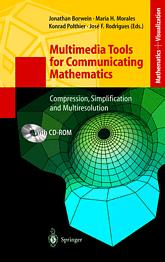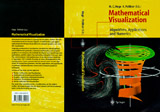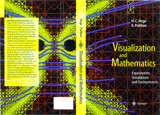

|
Sfb 288 Differential Geometry and Quantum Physics |
 Books
Books
Global Analysis: Differential Forms in Analysis, Geometry and Physics
by Ilka Agricola and Thomas Friedrich
Series: Graduate Studies in Mathematics
American Mathematical Society, 2002
ISBN: 0-8218-2951-3This book is devoted to differential forms and their applications in various areas of mathematics and physics. Well-written and with plenty of examples, this introductory textbook originated from courses on geometry and analysis and presents a widely used mathematical technique in a lucid and very readable style. The authors introduce readers to the world of differential forms while covering relevant topics from analysis, differential geometry, and mathematical physics.
The book begins with a self-contained introduction to the calculus of differential forms in Euclidean space and on manifolds. Next, the focus is on Stokes' theorem, the classical integral formulas and their applications to harmonic functions and topology. The authors then discuss the integrability conditions of a Pfaffian system (Frobenius's theorem). Chapter 5 is a thorough exposition of the theory of curves and surfaces in Euclidean space in the spirit of Cartan. The following chapter covers Lie groups and homogeneous spaces. Chapter 7 addresses symplectic geometry and classical mechanics. The basic tools for the integration of the Hamiltonian equations are the moment map and completely integrable systems (Liouville-Arnold Theorem). The authors discuss Newton, Lagrange, and Hamilton formulations of mechanics. Chapter 8 contains an introduction to statistical mechanics and thermodynamics. The final chapter deals with electrodynamics. The material in the book is carefully illustrated with figures and examples, and there are over 100 exercises.
Readers should be familiar with first-year algebra and advanced calculus. The book is intended for graduate students and researchers interested in delving into geometric analysis and its applications to mathematical physics.

Multimedia Tools for Communicating Mathematics
Eds: J. Borwein, M. Morales, K. Polthier, J.F. Rodrigues
Springer Verlag, 2002, ISBN 3-540-42450-4This book on multimedia tools for communicating mathematics arose from presentations at an international workshop organized at the Centro de Matemática e Aplicações Fundamentais at the University of Lisbon, in November 2000, with the collaboration of the Sonderforschungsbereich 288 at the University of Technology in Berlin, and of the Centre for Experimental and Constructive Mathematics at Simon Fraser University in Burnaby, Canada. The MTCM2000 meeting aimed at the scientific methods and algorithms at work inside multimedia tools, and it provided an overview of the range of present multimedia projects, of their limitations and the underlying mathematical problems. The workshop gathered fifty seven participants, twenty nine presentations and a round table. It took place under the auspices of the Sociedade Portuguesa de Matematica and the European Mathematical Society, and was sponsored by a special grant from the Fundação para a Ciência e a Tecnologia of Portugal.

Painleve Equations in the Differential Geometry of Surfaces
by A.I. Bobenko and U. Eitner
Lecture Notes in Mathematics 1753, Springer 2000, 120 pp., ISBN 3-540-41414-2This book brings together two different branches of mathematics: the theory of Painlevé and the theory of surfaces. Self-contained introductions to both these fields are presented. It is shown how some classical problems in surface theory can be solved using the modern theory of Painlevé equations. In particular, an essential part of the book is devoted to Bonnet surfaces, i.e. to surfaces possessing families of isometries preserving the mean curvature function. A global classification of Bonnet surfaces is given using both ingredients of the theory of Painlevé equations: the theory of isomonodromic deformation and the Painlevé property. The book is illustrated by plots of surfaces. It is intended to be used by mathematicians and graduate students interested in differential geometry and Painlevé equations. Researchers working in one of these areas can become familiar with another relevant branch of mathematics.

Globale Analysis - Differentialformen in Analysis, Geometrie und Physik
by Ilka Agricola and Thomas Friedrich
Vieweg, 2000Das vorliegende Buch beabsichtigt, den Leser in die Welt der Differentialformen einzuführen und zugleich diejenigen Themen der Mathematik und der Mathematischen Physik zu behandeln, in denen Formen besonders wichtig sind. Es entstand nach zahlreichen Vorlesungen über Analysis und Differentialgeometrie an der Humboldt-Universität zu Berlin für Studenten des zweiten und dritten Studienjahres. Vom Leser werden nur diejenigen algebraischen und analytischen Kenntnise erwartet, welche er im Verlauf eines Jahres des Studiums der Mathematik oder anderer Naturwissenschaften erwirbt. An einen solchermaßen vorbereiteten Leser wendet sich das Buch und versucht ihn nunmehr, in die Vektoranalysis, die Pfaffschen Systeme, die Differentialgeometrie der Kurven und Flächen im euklidischen Raum, in die symplektische Geometrie und Mechanik, die statistische Mechanik und Thermodynamik und letztlich in die Elektrodynamik zu begleiten.
Dirac Operators in Riemannian Geometry
by Thomas Friedrich
Series Graduate Studies in Mathematics, AMS 2000, approximately 208 pp., Hardcover, ISBN 0-8218-2055-9, List: $34, All AMS Members: $27This book was written after a one-semester course held at Humboldt-University in Berlin during 1996/97. It contains an introduction to the theory of spinors and Dirac operators on Riemannian manifolds. The reader is supposed to have only basic knowledge of Algebra and Geometry as a two - or three year study in Mathematics or Physics should provide them.
The presentation starts with an algebraic part comprising Clifford algebras, spin groups and the spin representation. The topological aspects concerning the existence and classification of spin reductions of principal $SO(n)$-bundles are discussed in Chapter 2. Here the approach essentially requires only elementary covering theory of topological spaces. At the same time, each result will also be translated into the cohomological language of characteristic classes. The subsequent Chapter 3 deals with analysis in the spinor bundle, the twistor operator and the Dirac operator in detail. Here the general techniques of principal bundles and the theory of connections are applied systematically. To make the book more self-contained, these results of modern differential geometry are presented without proof in the Appendix. Chapter 4 contains special proofs for the analytic properties of Dirac operators (essential self-adjointness, Fredholm property) avoiding the general theory for elliptic pseudo-differential operators. Eigenvalue estimates and solution spaces of special spinorial field equations (Killing spinors, twistor spinors) are the topic of Chapter 5. We mainly discuss the general approach, referring to the literature for detailed investigations of these problems. The book is concluded in Chapter 6 with a rewritten version of a talk on Seiberg-Witten theory.

Discrete Integrable Geometry and Physics
Edited by Alexander I. Bobenko and Ruedi Seiler
Oxford University Press, 1999Recent interactions between the fields of geometry, classical and quantum dynamical systems, and visualization of geometric objects such as curves and surfaces have led to the observation that most concepts of surface theory and of the theory of integrable systems have natural discrete analogues. These are characterized by the property that the corresponding difference equations are integrable, and has led in turn to some important applications in areas of condensed matter physics and quantum field theory, amongst others. This book combines the efforts of a distinguished team of authors from various fields of mathematics and physics in an attempt to provide an overview of the subject. The mathematical concepts of discrete geometry and discrete integrable systems are first presented as fundamental and valuable theories in themselves. In later chapters these concepts are put into the context of classical and quantum dynamics. For the introduction and table of contents see Sfb 288 preprint 325.
Dirac-Operatoren in der Riemannschen Geometrie
by Thomas Friedrich
Vieweg, 1997Das Buch entstand nach einer einsemestrigen Vorlesung an der Humboldt-Universität zu Berlin im Studienjahr 1996/97 und ist eine Einführung in die Theorie der Spinoren und Dirac-Operatoren über Riemannschen Mannigfaltigkeiten. Vom Leser werden nur die grundlegenden Kenntnisse der Algebra und Geometrie im Umfang von zwei bis drei Jahren eines Mathematik- oder Physikstudiums erwartet. Ein Anhang gibt eine Einführung in das aktuelle Gebiet der Seiberg-Witten-Theorie.
A Course on: Quantum Field Theory and Local Observables
by B. SchroerThe backbone of this modern course on QFT is the new concept of modular localization which not only incorporates the bootstrap-formfactor construction of low-dimensional QFT with the main stream of local quantum physics, but also links it to the Hawking-Unruh-Rindler phenomenon and to black hole physics near horizons.

Mathematical Visualization
Edited by Hans-Christian Hege and Konrad Polthier
Springer, 1998Algorithms for mathematical visualization problems, applications and experiments in geometry, and techniques for numerics and computer graphics.

Visualization and Mathematics
Edited by Hans-Christian Hege and Konrad Polthier
Springer, 1997Selected contributions from the international workshop Visualization and Mathematics, Berlin 1995